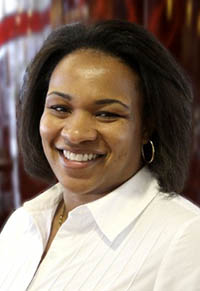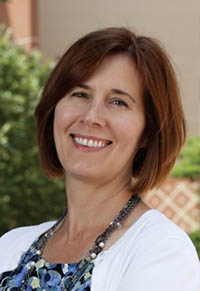Faculty members embrace remote learning amid pandemic
Update | Monday, April 13, 2020
As the coronavirus pandemic swept across the nation, colleges and universities in Ohio were among the first to close campuses and shift to remote learning. For Columbus State, the timing worked well. It was the middle of spring break when the College decided to cancel classes the following week. That allowed extra time for faculty and staff to swiftly modify all in-class sections to be delivered remotely. Faculty members have spent the final weeks of the semester adapting alongside their students to a fully virtual instruction landscape.
 Paul Carringer, who began at Columbus State in 2001, has been teaching via remote instruction in
some form or another for at least 15 years. As an associate professor of marketing,
he has eight classes this semester, two of which were in-class sections.
Paul Carringer, who began at Columbus State in 2001, has been teaching via remote instruction in
some form or another for at least 15 years. As an associate professor of marketing,
he has eight classes this semester, two of which were in-class sections.
Carringer says his biggest concern is losing students because of the change. “With the face-to-face class format, I know that I will ‘see’ students. Online, students can fade into the background without close attention being paid to their progress.” To maintain a connection, Carringer checks in via email and Blackboard Collaborate. And he uses Google Forms polling to see how students are doing, both in class and outside. He adds, “Most of all, I have worked to respond faster to student emails and texts.”
 Two of the five sections being taught by Antoinette Perkins, a professor in sport exercise and hospitality programs, were originally in-class.
“One of the hurdles to converting those sections was not knowing if the students would
be able to access the materials that were now offered online.” She says picking user-friendly
methods was a challenge.
Two of the five sections being taught by Antoinette Perkins, a professor in sport exercise and hospitality programs, were originally in-class.
“One of the hurdles to converting those sections was not knowing if the students would
be able to access the materials that were now offered online.” She says picking user-friendly
methods was a challenge.
Maintaining contact is now an ongoing focus. “I am able to stay connected with students through Blackboard Collaborate, personal phone calls, and emails,” she says, adding that students have been understanding in the decision to move instruction to remote delivery. “They respect the fact that faculty are also understanding of the current situation that students have been suddenly placed in..” Perkins says a best practice she follows is to keep it simple when transitioning an in-class section to a virtual section quickly.
 Steve Levin is an associate professor in the Engineering & Transportation Technology Department.
He first taught at Columbus State in the 1990s and then returned in 2011. All four
of his sections were in-class. Two of them were eight-week classes that wrapped up
before the break. One is currently moved to remote instruction. The other, which was
scheduled for the second eight-week term, had to be canceled. It was a mostly hands-on
section scheduled for the Automotive Technology Lab.
Steve Levin is an associate professor in the Engineering & Transportation Technology Department.
He first taught at Columbus State in the 1990s and then returned in 2011. All four
of his sections were in-class. Two of them were eight-week classes that wrapped up
before the break. One is currently moved to remote instruction. The other, which was
scheduled for the second eight-week term, had to be canceled. It was a mostly hands-on
section scheduled for the Automotive Technology Lab.
Levin has used emails and Blackboard announcements to stay connected to the remaining students. “For the one course that did convert online, I use Blackboard Collaborate, and the students have been pretty engaged. I think many of them were even surprised by what we can teach and that they can learn when it’s online.”
 Lisa Cerrato started at the College at the inception of the Health Information Management Technology
(HIMT) program in 1991. All of her classes (and nearly all HIMT classes), were already
online.
Lisa Cerrato started at the College at the inception of the Health Information Management Technology
(HIMT) program in 1991. All of her classes (and nearly all HIMT classes), were already
online.
As an allied health professor, she is also serving as the professional practice experience (PPE) coordinator this semester. The PPE coordinator is a crucial role which places students in internships, helps students prepare for national certification exams and the job market, and assists with coordinating capstone presentations.
Cerrato says, “Fortunately, due to the nature of our program – and our profession in general – it was not much of a transition since HIMT courses are already delivered in an online format. And many jobs in the health information management (HIM) profession are already remote. For example, medical coders work from home at Ohio State University’s Wexner Medical Center, OhioHealth, and Mt. Carmel Health System. Therefore, working remotely is not new to the HIMT or the HIM profession.”
 Three of Jon Kreger’s seven sections were in-class at the start of the semester. The associate professor
of political science has been with Columbus State since 2009. Even with the extra
week after spring break, Kreger, a lead instructor, says converting classes in his
department was a heavy lift.
Three of Jon Kreger’s seven sections were in-class at the start of the semester. The associate professor
of political science has been with Columbus State since 2009. Even with the extra
week after spring break, Kreger, a lead instructor, says converting classes in his
department was a heavy lift.
“One major challenge was finding the right balance when communicating with students. There was a lot of information that had to be conveyed, but I didn't want to inundate them with too much information to the point they would tune me out,” he says.
Another challenge is staying connected. “I’m using Blackboard Collaborate to host virtual office hours during the week and exam review sessions,” says Kreger. “At first students, who are used to meeting on campus were slow to participate in the virtual environment, but their participation has been steadily improving each week.”
Each faculty member praised Digital Education and Instructional Services (DEIS) for their nonstop efforts to assist, train, and acclimate everyone ahead of the resumption of the semester. “The Blackboard system was already commonly used by all classes,” says Perkins. “Having a consistent delivery system has given students a one-stop virtual location.” Kreger says, “The training and support provided by DEIS has been invaluable.”
There were also compliments for departmental and College leadership. “Their helpful attitude has been most appreciated,” says Carringer. “Support was offered at all levels,” says Cerrato. “From the president, to Dr. Simons, to the Women’s ERG, to DEIS, to the IT Support Center and beyond. Everyone really stepped up their efforts to serve one another during this time.”
Cerrato adds, “I genuinely believe that this pandemic, in a strange way, will make the campus community stronger and only deepen the love and compassion we have for our students and each other and the mission of Columbus State and the communities we serve."
Go to 2020 Update Archive Go to Employee Update
Latest Update Stories